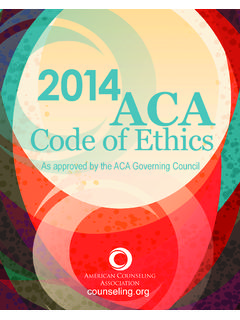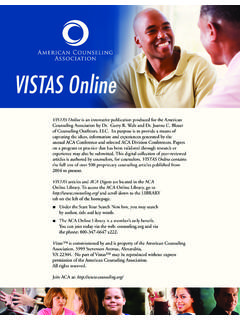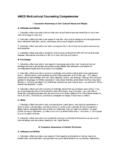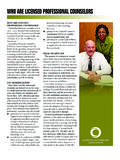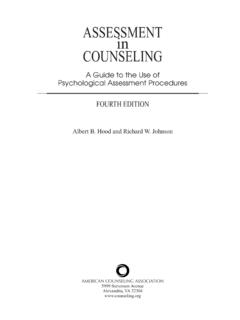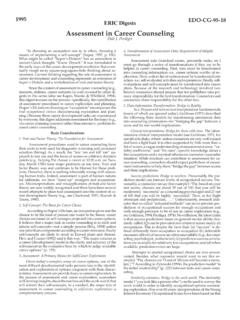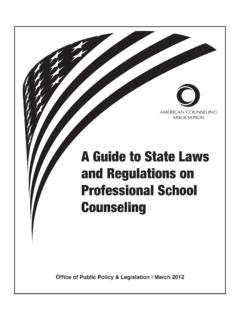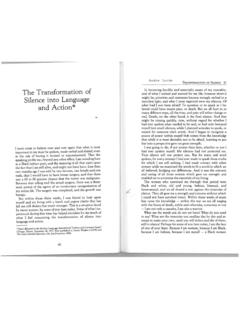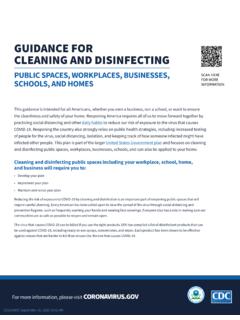Transcription of April 1994 EDO-CG-94-02
1 April 1994 EDO-CG-94-02 Effective Group CounselingSamuel T. GladdingThere is a natural tendency for people to gather ingroups for mutually beneficial purposes. Throughgroups, individuals accomplish goals and relate to oth-ers in innovative and productive ways (McClure, 1990).People would not survive , let alone thrive, withoutinvolvement in groups. This reliance and interdepen-dence is seen in all types of groups from those that areprimarily task-oriented to those that are order to be effective, group leaders must be awareof the power and potency of groups. They must planahead and they must be sensitive to the stage of develop-ment of the group. Equipped with this knowledge theycan utilize appropriate skills to help their groups developfully (Gladding, 1994).
2 Proper preparation and strategicintervention increase the chance of running a counselinggroup smoothly and Counseling GroupsA crucial element in starting counseling groups ismaking decisions beforehand. Pregroup planning is thefirst step in the process. Leaders design groups so thatthey will yield productive and pragmatic results for par-ticipants. Among the most important considerations arethose associated with objectives, membership, rules, time,place, and of Group CounselingGroup counseling involves individuals who are hav-ing difficulties they wish to resolve that are of a personal,educational, social, or vocational nature (Corey & Corey,1992). These groups are primarily run in educational in-stitutions or agencies.
3 They deal with specific, non-pathological problems that members are aware of priorto joining and which do not involve major personalitychanges. For instance, group counseling may focus onhow members achieve such goals as relating better to theirfamilies, becoming organized, or relaxing in the presenceof supervisors at MembershipGroup membership is either homogeneous orheterogeneous. Homogeneous groups are composed ofindividuals who are similar, such as adolescent boys,single parents or individuals working with grief and lossissues. Heterogeneous groups are made up of people whodiffer in background, such as adults of various ages withvaried careers. While homogeneous groups can concen-trate on resolving one issue, their members may be lim-ited experientially.
4 In contrast, heterogeneous groupsoffer diverse but multifocused group leaders screen potential members be-fore accepting them. Screening allows leaders to selectmembers and members to select leaders and groups. Theideal group size of eight to 12 allows members an oppor-tunity to express themselves without forming into sub-groups. In order to help dispel and overcome miscon-ceptions about groups, leaders can utilize pregroup interviews to identify fears related to upcoming feedback and explanation, misunderstandingscan be immediately clarified and corrected (Childers &Couch, 1989).Rules in Counseling GroupsCounseling groups run best when the rules govern-ing them are few and clear.
5 If there are more than a dozenrules, many members will tend to forget some of , if the rules are vague, some members willinevitably violate the letter or spirit of them. In counsel-ing groups, rules should follow the ethical standards ofprofessional organizations, such as the Association forSpecialists in Group Work. Members should agree to keepeach others confidentiality, not attack each other verballyor physically, to actively participate in the group process,and to speak one at a and Place of GroupsAlthough counseling groups vary, members need aspecific, consistent time and place to meet. Most groupsmeet for one and one half to two hours each week for 12to 16 sessions.
6 The meeting room should be quiet andinviting and away from other activities. Groups workbest when chairs are arranged in circles where everyonefeels a sense of equality with one another and the flow ofcommunication is enhanced (Gladding, 1994).Group DynamicsGroup member interactions appear simple but theyare not. They are complex social processes that occurwithin groups and that affect actions and outcomes(Lewin, 1948). Group dynamics occur in all groups, andinvolve the interactions of group members and leadersover time, including the roles the members and the lead-ers take. Individuals have an impact on groups just asgroups influence members. The number of group inter-actions increases exponentially as the size of groupsgrows.
7 Therefore, keeping track of communication pat-terns in counseling groups is a demanding complexity of interaction is magnified by the factthat messages are sent within counseling groups on averbal as well as a nonverbal level. The nature of thiscommunication is crucial to comprehending what is hap-pening within groups. For example, a member whophysically or emotionally distances from a group influ-ences how the group operates as clearly as if he or shemakes a statement. As groups develop, members fre-quently switch roles and patterns of StagesIn addition to preplanning, effective group counsel-ing leaders recognize that groups go through five stages:dependency, conflict, cohesion, interdependence, and ter-mination.
8 The stages are often called forming, storm-ERIC DigestERIC Digests are in the public domain and may be freely reproduced and disseminated. This publication was funded by the Depart-ment of Education, Office of Educational Research and Improvement, Contract No. RR93002004. Opinions expressed in this report do notnecessarily reflect the positions of the Department of Education, OERI or information on other ERIC/CASS products and services, please call toll-free (800) 414-9769 or (910) 334-4114 or fax (910)334-4116 or write ERIC/CASS, School of Education, University of North Carolina at Greensboro, Greensboro, NC , norming, performing, and adjourning (Tuckman &Jensen, 1977).
9 Recognizing group stages gives counselors anopportunity to devise or utilize appropriate leadership first group stage is dependency or forming. Atthis time, group members are unsure of themselves and lookto their leaders or others for direction. This process givesmembers an opportunity to explore who they are in the groupand to begin establishing trust. The second stage in groupcounseling is conflict, or storming. It may be overt orcovert. The type and amount of conflict that is generatedrelates to how much jockeying for position goes on in three focuses on cohesion, or norming, which canbe defined as a spirit of we-ness.
10 In it, members becomecloser psychologically and are more relaxed. Everyone feelsincluded in the group and productive sharing begins tooccur. In the fourth stage, performing, the main work of thegroup is begun. Interdependence develops. Group mem-bers are able to assume a wide variety of constructive rolesand work on personal issues. The level of comfort in thegroup increases too. This is a prime time of problem occupies about 50% of a typical group s time. The finalstage, adjourning deals with termination. Issues of loss inseparating from the group are raised. Celebrating the accom-plishment of goals is also a primary focus within this Counseling SkillsAs with other groups, leaders of effective counselinggroups need to employ a variety of interpersonal skills (Corey& Corey, 1992).
